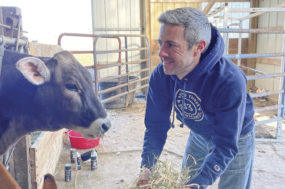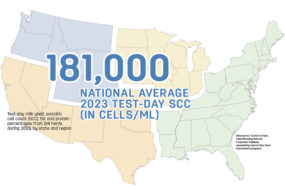Three years ago, Harry Faber was running low on sawdust bedding for his 250 milking cows, but when he called for more he was told more could not be received.
With some cows lying on bare concrete, he lost a few in his milking string and thought there must be a better way. Sawdust had been the bedding of choice at Faber Dairy LLC in Everson, Washington.
Sand is not readily available there and what can be found is harsh and coarse. The state’s wet weather eliminated composting as an option; that is until Faber talked with Dave DeWaard at DariTech, Inc. about a fully-enclosed composter.
Faber agreed to become the test dairy for the company’s new composter, the BeddingMaster. He dug a new 10x10x10-foot pit to collect manure scraped from the freestall barn. In the pit the manure is agitated on a regular basis before being pumped to a separator.
The liquids are removed and sent to Faber’s existing lagoon, while the solids enter one end of the 6x32-foot composter. They remain there until they reach 145°F, about three days. Composted material is stored in a three-bay commodity shed, allowing Faber to alternate bays to obtain bedding.
Faber uses 50 percent of the compost to bed his milking and dry cows. The rest is used to bed his heifers raised off-site and his son’s 220-cow dairy.
“I prefer (the composted bedding) over sawdust,” Faber says. “My somatic cell count, on the average, is lower with this versus sawdust.”
With sawdust, his SCC was 150,000. In the fall, winter and spring it was 120,000 with the composted bedding. This summer, when Washington State experienced above-average temperatures in the triple digits, the SCC climbed to 200,000, but with the cooler fall weather, Faber says it is coming back down again.
Other reasons Faber prefers the compost bedding is because less of it is needed to bed the stalls and the cows don’t kick as much of it around. It works very well in a sawdust blower, he says, and when blown to the front of the stalls it airs out nicely.
“Even in rainy weather it just gets so dry,” Faber comments. “I do find the cows are very clean. Cleaner than if you use sawdust.”
Previously, he had a problem with sawdust settling in the lagoon and building islands, which needed to be cleaned out with an excavator. That no longer exists now.
With fewer solids entering his lagoon, less agitation is required when he empties it. Just a little at the end, he says. Plus, Faber estimates there is 20 percent less material going into the lagoon, providing additional storage capacity.
Having been the test subject for DariTech, Faber says there were a few quirks at the beginning that needed to be worked through, but the company was very quick to fix them. The biggest problems came with the separator and establishing the right amount of pressure to obtain the level of dryness needed for the composter.
Now, those problems only occur when it rains too much and the 10’x10’x10’ pit becomes oversaturated. When he first sat down to figure his savings over sawdust, Faber determined he’d reach payback on the new composter in four years. That’s considering the price of sawdust stays the same.
“But how do you put a pencil to it if you cannot get sawdust and you start losing cows?” he asks. “That’s when it pays for itself much quicker.” ANM





